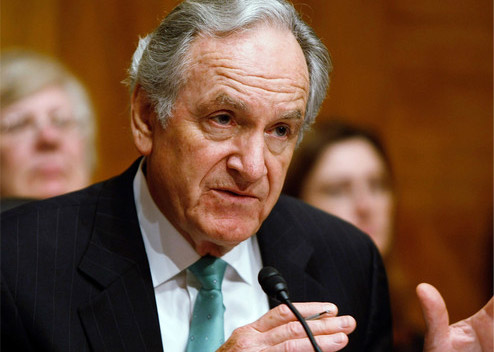Harkin Celebrates 23rd Anniversary of ADA with Update on Disability Employment Initiatives
July 26, 2013

|
Thank you for continuing to support my work to improve employment opportunities for individuals with disabilities. Let me take a moment to update you on important developments in this issue.
On July 26, 2013, the landmark Americans with Disabilities Act (ADA), which I was honored to co-author, turns 23 years old. When we wrote the ADA in 1990, our goal for individuals with disabilities was clear: ensure equal opportunity and full participation in society, improve access to independent living, and strengthen economic self-sufficiency. While we have made significant strides in our efforts to fully integrate people with disabilities into mainstream society, disability employment remains disappointingly stagnate.
For instance, although the economy continues to recover, the 12.5 percent unemployment rate for individuals with disabilities far exceeds the 7.6 percent rate for those without disabilities. Even this high rate underestimates the true number of working age individuals with disabilities who are unemployed, because it does not take into account those who have dropped out of the labor force altogether. Factoring in this statistic reveals that more than two out of every three working age individuals with disabilities are out of work.
As Chairman of the Senate Committee on Health, Education, Labor and Pensions (HELP), I am pursuing an aggressive disability employment agenda by challenging leaders from the public and private sector to hire more disabled employees, and by holding a series of HELP Committee hearings to shine a light on factors behind sluggish disability employment. My overall goal is to increase the disability workforce by one million Americans by 2015.
On May 31st, I attended a summit in Wilmington, Delaware, convened by key stakeholders from the state and federal government, philanthropy organizations, businesses, and the disability community. The message I heard from representatives from Walgreens, Wal-Mart, Bank of America, and Marriot, as well as from government representatives was that individuals with disabilities are hungry for meaningful work, and that employing these individuals improves the bottom line for many businesses.
Businesses like Walgreens are serving as an example to other companies by employing a workforce at their 20 distribution centers that includes at least 10 percent of people with disabilities and in some cases more than 40 of their workforce. Lowe's and Best Buy have also committed to increasing disability employment, and Wal-Mart will hire at least 100,000 veterans, many of whom have service-connected disabilities. At the Delaware summit I also heard from philanthropic organizations that stand ready to deliver greater financial resources to increase disability employment. I learned that only three to six percent of the $47 billion in annual private giving goes towards disability initiatives, indicating there is vast potential to expand targeted giving and grant-making opportunities through private sector partnership.
In addition, I heard from Delaware Governor Jack Markell, the outgoing Chair of the National Governors Association (NGA), about the year-long NGA initiative to identify and evaluate employment barriers for people with disabilities. The NGA goal is to develop a blueprint for businesses and states that identifies best employment practices and facilitates government and private disability employment.
Finally, you may also be interested to know I intend to hold a HELP Committee markup of the Workforce Investment Act (WIA), which includes provisions of the Vocational Rehabilitation Act that strengthen employment opportunities, research, and independent living services and supports for individuals with disabilities. These provisions will help close the disability employment gap by ensuring that young people with disabilities are fully prepared for life after school, and have access to the same range of internships, part-time employment, and summer work opportunities as their peers without disabilities.
The 23rd anniversary of the ADA marks a turning point, where an entire generation of disabled young adults has grown up under the protections of the ADA. This "ADA generation" and all Americans with disabilities stand ready to seize employment opportunities and fully realize the promise of the ADA to guarantee full access to all aspects of society. I hope you will take a moment to watch a short video message (http://bit.ly/19mYZZt) commemorating the anniversary, and that you will continue to join your voice with mine as I advocate for individuals with disabilities.
For all of the latest on this and other issues, please visit http://harkin.senate.gov, my Facebook page at http://www.facebook.com/tomharkin or follow me on Twitter https://twitter.com/#!/SenatorHarkin.







